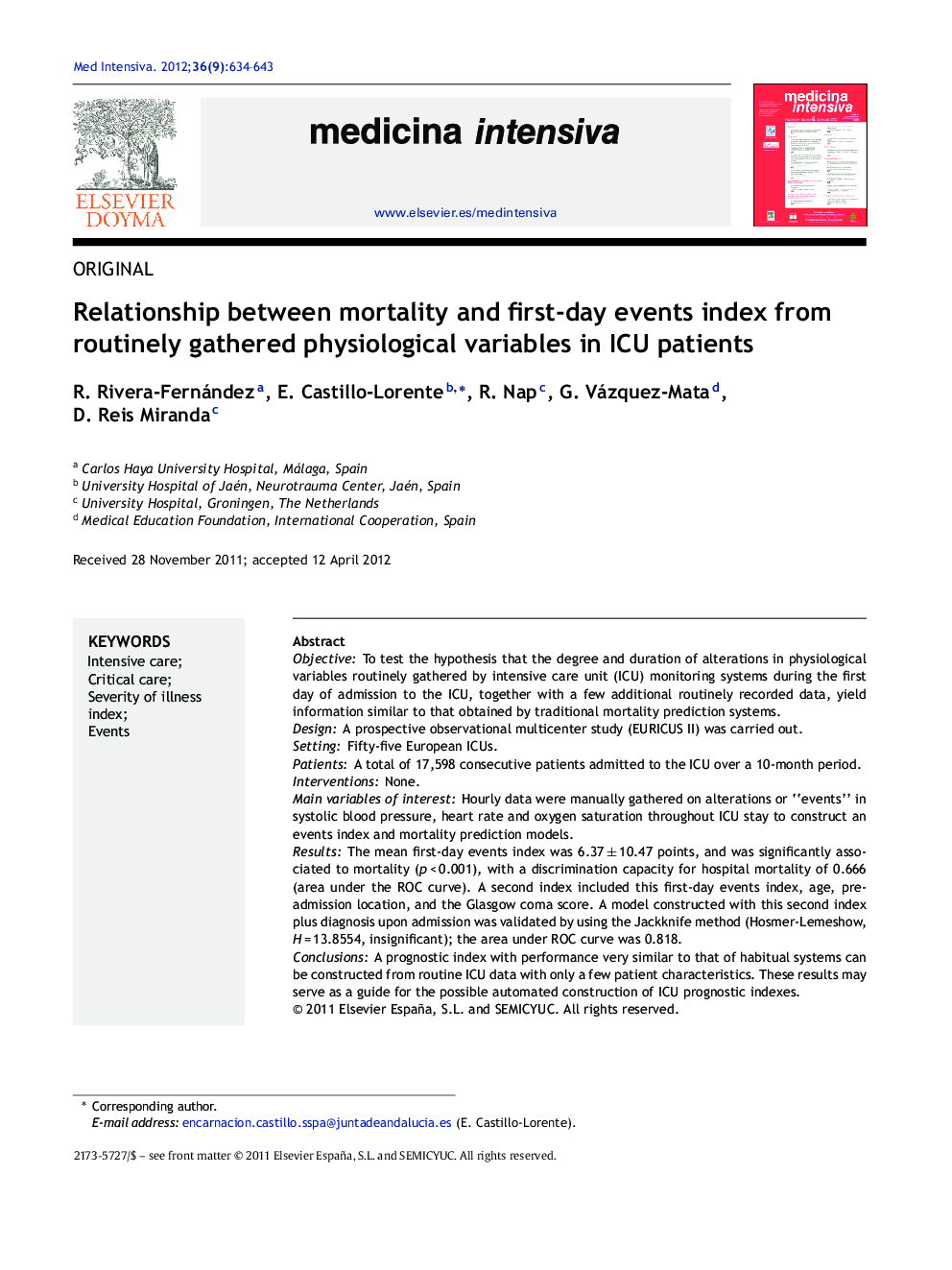| کد مقاله | کد نشریه | سال انتشار | مقاله انگلیسی | نسخه تمام متن |
|---|---|---|---|---|
| 3114132 | 1192491 | 2012 | 10 صفحه PDF | دانلود رایگان |

ObjectiveTo test the hypothesis that the degree and duration of alterations in physiological variables routinely gathered by intensive care unit (ICU) monitoring systems during the first day of admission to the ICU, together with a few additional routinely recorded data, yield information similar to that obtained by traditional mortality prediction systems.DesignA prospective observational multicenter study (EURICUS II) was carried out.SettingFifty-five European ICUs.PatientsA total of 17,598 consecutive patients admitted to the ICU over a 10-month period.InterventionsNone.Main variables of interestHourly data were manually gathered on alterations or “events” in systolic blood pressure, heart rate and oxygen saturation throughout ICU stay to construct an events index and mortality prediction models.ResultsThe mean first-day events index was 6.37 ± 10.47 points, and was significantly associated to mortality (p < 0.001), with a discrimination capacity for hospital mortality of 0.666 (area under the ROC curve). A second index included this first-day events index, age, pre-admission location, and the Glasgow coma score. A model constructed with this second index plus diagnosis upon admission was validated by using the Jackknife method (Hosmer-Lemeshow, H = 13.8554, insignificant); the area under ROC curve was 0.818.ConclusionsA prognostic index with performance very similar to that of habitual systems can be constructed from routine ICU data with only a few patient characteristics. These results may serve as a guide for the possible automated construction of ICU prognostic indexes.
ResumenObjetivoComprobar si el grado y duración de las alteraciones en las variables fisiológicas recogidas en la monitorización rutinaria en UCI durante el primer día de estancia, junto con pocos datos adicionales, proporcionan información similar a la obtenida con los sistemas tradicionales de predicción de mortalidad.DiseñoEstudio observacional, prospectivo y multicéntrico (EURICUS-II).Ámbito55 UCIs de Europa.Pacientes17.598 pacientes consecutivos, ingresados durante 10 meses.Intervencionesninguna.Variables de interés principalesse recogieron manualmente datos horarios sobre alteraciones o “eventos” en la presión arterial sistólica, frecuencia cardiaca y saturación de oxígeno, para construir un índice basado en estos eventos y un modelo de predicción de mortalidad.ResultadosEl índice de eventos el primer día fue 6,37 ± 10,47 puntos y se asoció significativamente con la mortalidad (p < 0,001), con una capacidad de discriminación (área bajo la curva ROC) para la mortalidad de 0.666. Se construyó un segundo índice que incluye este índice de eventos en el primer día, la edad, procedencia del ingreso y puntuación de la Escala de Coma de Glasgow. Un modelo construido con este segundo índice más el diagnóstico fue validado mediante el método jackknife (Hosmer-Lemeshow, H = 13.8554, no significativo), con un área bajo la curva ROC de 0,818.ConclusionesSe puede construir un índice pronóstico con rendimiento similar al de los sistemas habituales a partir de los datos de monitorización de los pacientes en la UCI junto a escasas características del paciente. Nuestros resultados pueden servir de guía para la posible construcción automatizada de índices pronósticos.
Journal: Medicina Intensiva (English Edition) - Volume 36, Issue 9, December 2012, Pages 634–643